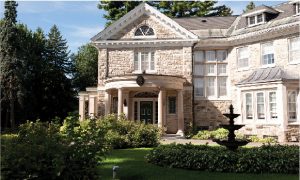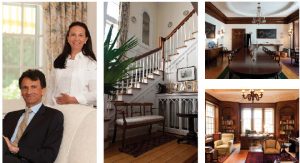
The phrase “It was a dark and stormy night” might echo the thoughts of the new Italian ambassador when he arrived at his home on the Aylmer Road on a dark, frigid January night this year. But when he woke up, he found he was in one of the most beautiful diplomatic residences in the national capital region.
“It’s a little isolated, but it’s beautiful,” says Andrea Meloni. “It was not the best welcome, but the next day was sunny and the house looked fantastic.”
The cut-stone Aylmer Road mansion, built by lumber baron Robert L. Blackburn in 1924, is large and elegant, sitting on 2½ hectares of land next to the elite Royal Ottawa Golf Club. From its site on a hill, and past the entrance where a small fountain tinkles a merry tune, the house shows complementary charms on the inside.
Blackburn designed the house himself with help from John Pearson, the architect for the Parliament buildings when they were re-built after their destruction by fire in 1916. Ottawa artist Jennifer Dickson suggests in a book she wrote about the residence that the stone of the house was quarried at the same location as the stone for Parliament.
The Italian government bought the house in 1956 from Blackburn’s daughters, one of whom lives next door.

“The house is cleverly designed,” says the ambassador. An abundance of large windows, the design of the rooms, and some irregular angles assure there is light in every space. The curved ceiling of the entrance hall, the nine windows lighting up the foyer and the polished oak staircase, all invite guests into the glamorous interior.
Elaborate woodwork and plaster cornices detail the main floor reception rooms, including the drawing room that runs almost the length of the house. This room has ceiling plaster work and a Carrara marble fireplace, all lit by two large crystal chandeliers. Neapolitan-era paintings of cherubs demand attention from one end of the room, while two Corinthian columns highlight a deep bay window area.
These rooms are carpeted with oriental rugs the ambassador and his wife, Paola Bracci, have collected over the years. The pair has had many postings, most recently in Brussels, where two of their three children live.
A bright conservatory with an informal tiled floor has windows facing the garden and the large loggia, used as an awning-covered concert stage by Opera Lyra at its annual fundraising garden party.
Ambassador Meloni has moved his favourite desk, made in Pakistan, to the library, a dark walnut-panelled enclave with recessed book shelves. The plaster-covered ceiling beams are decorated with floral emblems, including the fleur-de-lis, the rose of York and the thistle of Scotland. In her book, Dickson again suggests that the same plasterers and cabinet makers who worked under Pearson on Parliament Hill, may have worked at the residence as well.
Among other points of interest is the dining room, set at a 38-degree angle to the rectangle of the house. It boasts an oval ceiling medallion with Canadian flora in its stucco design, and a dining room table in the style of Thomas Sheraton that seats 18.
Dinner often features Italian favourites but the menu varies depending on the guests, the ambassador says with a laugh.
“If someone is familiar with the techniques of Italian food, we might serve tagliatelle. If not, the menu might include risotto, which anyone can manage.”
We sample flaky crostata cookies, provided by the residence’s cook, who, while not Italian herself, has worked at the residence so long she has learned all the subtleties of fine Italian cuisine. A full-time maid and a part-time driver/butler keep the residence ship-shape.
As we leave, Ms. Bracci points to a delicate reminder of her homeland. I love this,” she says, pointing to a small lemon tree.
Margo Roston is Diplomat’s culture editor.




